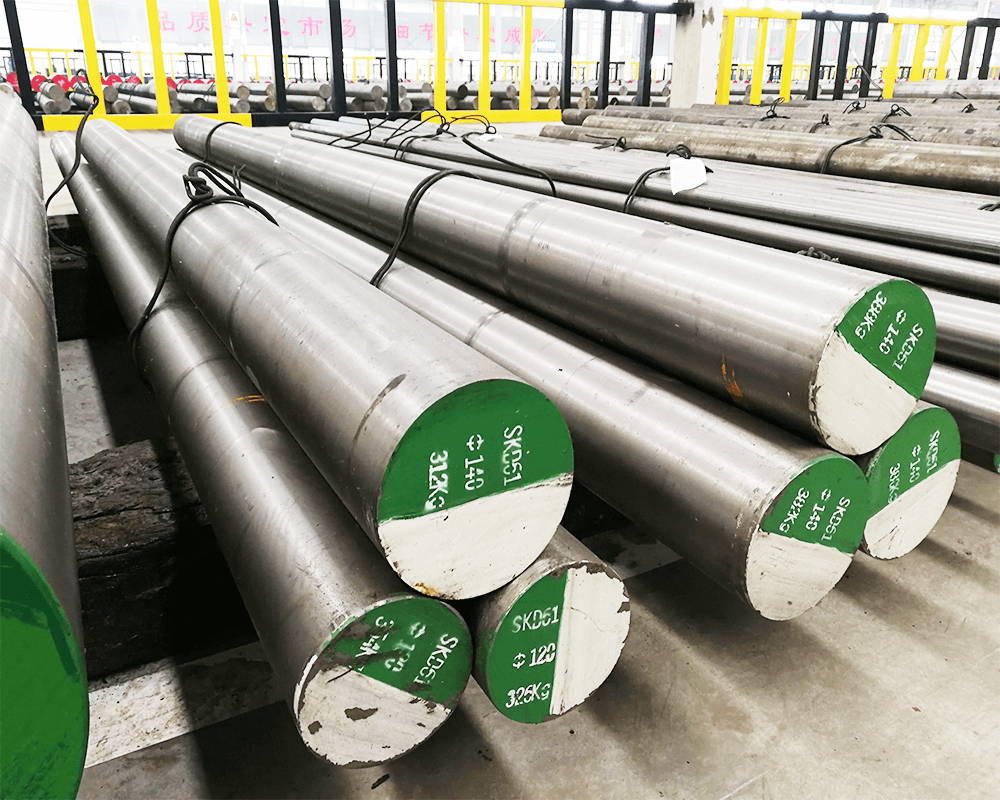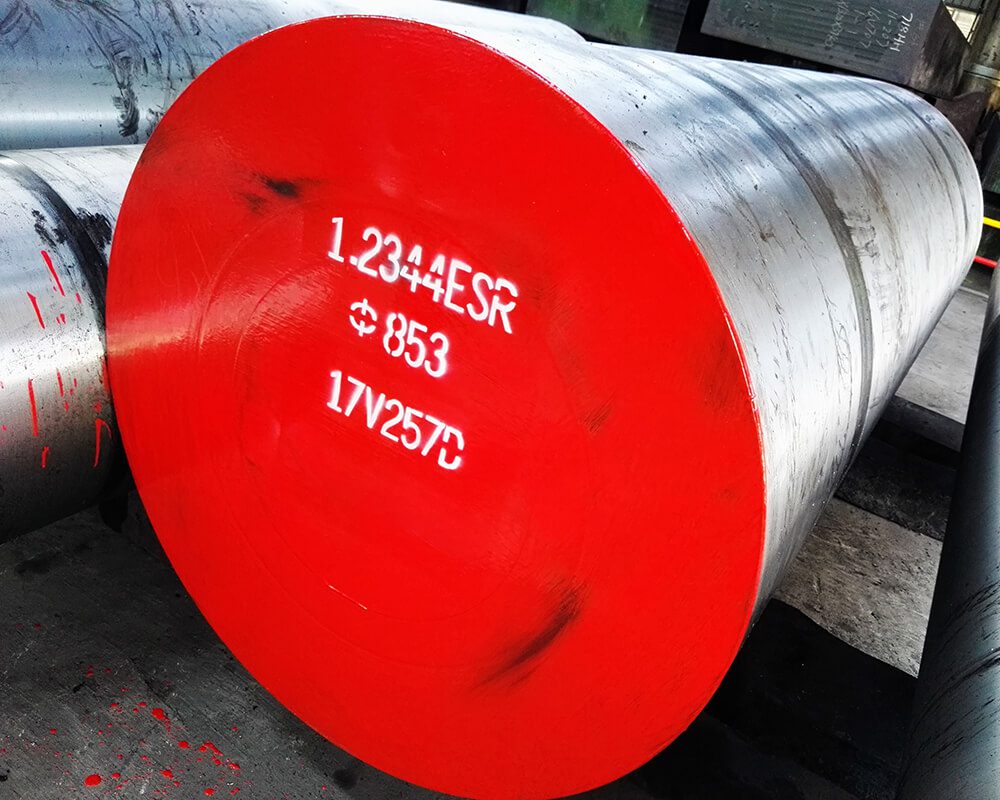
HOT WORK DIE STEEL
Common grades of hot work tool and die steels include H13, H11, H21, and H19, among others. The choice of steel grade depends on the specific requirements of the application, including temperature resistance, wear resistance, and machinability.
Hot work tool and die steels are essential for maintaining tool and die integrity in high-temperature industrial processes, ensuring the quality and consistency of the manufactured products.
Application
Die Casting: Hot work tool and die steels are used for dies and inserts in die-casting processes, where molten metal is injected into molds under high pressure and temperature.
Forging: They are used for dies and tools in the forging industry to shape metal at elevated temperatures.
Extrusion: Hot work tool and die steels are employed in extrusion dies for producing products like metal rods, profiles, and tubes.
Hot Stamping: In hot stamping processes for automotive parts, these steels are used for dies and punches to shape high-strength steel sheets.
Hot Shearing: Hot work steels are used for cutting and shearing operations in applications like steel mills.
Glass Manufacturing: Some hot work steels are used in glass mold manufacturing for products like bottles and glass containers.
Plastic Molding: While primarily used for metalworking, hot work steels may also be used in some high-temperature plastic molding applications.
Tooling for High-Temperature Processes: These steels are used in tooling for various high-temperature processes, including heat treating, hot rolling, and high-temperature brazing.
Extrusion and Drawing of Non-Ferrous Metals: Hot work tool and die steels are used in the extrusion and drawing of non-ferrous metals like aluminum, copper, and brass.
Metal Recycling: In metal recycling facilities, hot work tool and die steels are used for shredder blades and other equipment that handle and process scrap metal.
Aerospace: Hot work tool and die steels are used in aerospace applications for tools and dies used in high-temperature forming and manufacturing processes.
Energy Industry: These steels find use in power generation equipment, including turbine blade dies and components for boilers and generators.

WE OFFER
| Steel Type | GERMANY | AISI | Sweden | JAPAN | FUSHUN | Grade | Hardness HB or HRC | Ultrasonic TEST | Hot rolled plate sizes range | Hot forged plate and block sizes range | Round bar sizes range |
| Hot Work Die Steel | 1.2343 ESR | H11 | — | — | FT2343 ESR | 1.2343 ESR/H11 ESR | Annealed ≤230HB | Sep1921-84 E/e | Thick 20-90mm x Width 200-305mm | Thick 100-800mm x Width 500-1200mm | |
| 1.2344 ESR | H13 | 8402 | SKD61 | FS413 ESR | 1.2344 ESR/H13 ESR | Annealed ≤230HB | Sep1921-84 E/e | Thick 20-90mm x Width 200-305mm | Thick 100-500mm x Width 500-1200mm | Machined Dia 20-700mm | |
| 1.2367 ESR | H13 Mod-superior | DIEVAR | DAC55 | FT8418 ESR | 1.2367 ESR | Annealed ≤230HB | Sep1921-84 E/e | Thick 20-90mm x Width 200-305mm | Thick 100-500mm x Width 500-1200mm |
High Temperature Resistance: Hot work tool and die steels maintain their strength and hardness even at elevated temperatures, typically ranging from 400°C (752°F) to 600°C (1112°F) and higher.
Excellent Toughness: These steels offer good toughness and resistance to thermal fatigue, preventing cracking and damage under cyclic heating and cooling conditions.
Wear Resistance: They have excellent wear resistance, which is crucial in applications involving contact with hot metal, such as dies, punches, and extrusion tools.
Good Thermal Conductivity: Hot work steels often have good thermal conductivity, helping to dissipate heat and maintain temperature uniformity within the tool or die.
Machinability: Some hot work steels are designed for good machinability, allowing for ease of fabrication and tool manufacturing.
Common Applications:
Die Casting: Hot work tool and die steels are used for dies and inserts in die-casting processes, where molten metal is injected into molds under high pressure and temperature.
Forging: They are used for dies and tools in the forging industry to shape metal at elevated temperatures.
Extrusion: Hot work tool and die steels are employed in extrusion dies for producing products like metal rods, profiles, and tubes.
Hot Stamping: In hot stamping processes for automotive parts, these steels are used for dies and punches to shape high-strength steel sheets.
Hot Shearing: Hot work steels are used for cutting and shearing operations in applications like steel mills.
Glass Manufacturing: Some hot work steels are used in glass mold manufacturing for products like bottles and glass containers.
Plastic Molding: While primarily used for metalworking, hot work steels may also be used in some high-temperature plastic molding applications.
Tooling for High-Temperature Processes: These steels are used in tooling for various high-temperature processes, including heat treating, hot rolling, and high-temperature brazing.
Extrusion and Drawing of Non-Ferrous Metals: Hot work tool and die steels are used in the extrusion and drawing of non-ferrous metals like aluminum, copper, and brass.
Metal Recycling: In metal recycling facilities, hot work tool and die steels are used for shredder blades and other equipment that handle and process scrap metal.
Aerospace: Hot work tool and die steels are used in aerospace applications for tools and dies used in high-temperature forming and manufacturing processes.
Energy Industry: These steels find use in power generation equipment, including turbine blade dies and components for boilers and generators.
The AISI (American Iron and Steel Institute) classification system includes several grades of hot work tool and die steels. These grades are designated with a prefix “H” followed by a number. Here are some common AISI grades of hot work tool and die steels:
AISI H13: This is one of the most widely used hot work tool steel grades. It is known for its excellent combination of high-temperature strength, wear resistance, and toughness. AISI H13 is commonly used for die casting dies, extrusion dies, and hot forging dies.
AISI H11: AISI H11 is another hot work tool steel with good high-temperature strength and resistance to thermal fatigue. It is used in applications such as forging dies and extrusion tools.
AISI H21: AISI H21 is a tungsten-containing hot work tool steel known for its high-temperature strength and excellent heat resistance. It is used in applications involving high-temperature tooling, such as die casting and hot extrusion.
AISI H19: AISI H19 is a chromium-molybdenum hot work tool steel with good heat resistance and wear resistance. It is often used for hot forging dies and extrusion tools.
AISI H10: AISI H10 is a hot work tool steel with good high-temperature strength and toughness. It is used in applications such as die casting dies and hot forging dies.
AISI H12: AISI H12 is a chromium-molybdenum-vanadium hot work tool steel known for its high-temperature strength and resistance to thermal fatigue. It is used in applications involving hot stamping and hot forging.
AISI H14: AISI H14 is a tungsten-containing hot work tool steel known for its high-temperature strength and good heat resistance. It is used in applications such as die casting and hot extrusion.
These are some examples of AISI hot work tool and die steel grades. Each grade has its own unique combination of properties, making it suitable for specific high-temperature applications. When selecting a hot work tool steel grade, factors such as temperature resistance, wear resistance, toughness, and machinability must be considered based on the requirements of the tool or die application.
Various countries and regions have their own classification systems and designations for hot work tool and die steels, which may differ from the AISI (American Iron and Steel Institute) system commonly used in North America.
These classification systems are established by national or international standards organizations to categorize and specify tool and die steels based on their composition and properties. Here are some examples of such systems used in different countries:
DIN (Deutsches Institut für Normung – German Institute for Standardization): Germany uses the DIN system to classify hot work tool and die steels. For instance, “DIN 1.2344” is a widely used hot work tool steel known as H13 in the AISI system.
JIS (Japanese Industrial Standards): Japan uses the JIS system to designate hot work tool and die steels with alphanumeric codes. For example, “JIS SKD61” is equivalent to AISI H13.
ISO (International Organization for Standardization): ISO has international standards for tool steels, including hot work tool and die steels. An example is “ISO 4957 1.2344,” which is equivalent to AISI H13.
BS (British Standards): The British Standards Institution (BSI) uses its own system for categorizing tool steels. For instance, “BS 4659 BH13” is equivalent to AISI H13.
EN (European Norm): In Europe, hot work tool and die steels are often designated using EN standards. For example, “EN ISO 4957 1.2344” corresponds to AISI H13.
GB (Guobiao – Chinese National Standards): China uses the GB standard system to classify tool steels. For instance, “GB/T 1299 4Cr5MoSiV1” is equivalent to AISI H13.
The choice of classification system often depends on regional standards and industry practices. When working with hot work tool and die steels, it’s crucial to refer to the relevant standards and specifications to understand the properties and characteristics of a particular grade, regardless of the naming convention used.
Hot work tool and die steels are designed to withstand elevated temperatures and thermal stresses encountered in high-temperature applications such as hot forging, die casting, and extrusion.
These steels maintain their hardness, strength, and toughness even at high temperatures. Hot work tool and die steels are categorized differently in the AISI (American Iron and Steel Institute) system, commonly used in North America, and the DIN (Deutsches Institut für Normung – German Institute for Standardization) system, commonly used in Germany.
Here are some common hot work tool and die steel grades with their equivalents in both systems:
AISI and DIN Hot Work Tool and Die Steel Grades:
AISI H13 (DIN 1.2344): AISI H13 is a widely used chromium-molybdenum hot work tool steel known for its high temperature strength, resistance to thermal fatigue, and good toughness. It is commonly used for applications like die casting and extrusion dies.
AISI H11 (DIN 1.2343): AISI H11 is a chromium-molybdenum hot work tool steel with good resistance to thermal shock and thermal fatigue. It is used for applications that require high-temperature strength and toughness.
AISI H21 (DIN 1.2581): AISI H21 is a tungsten hot work tool steel known for its high red hardness and resistance to heat checking. It is used for applications like hot forging dies and extrusion tools.
AISI H10 (DIN 1.2365): AISI H10 is a chromium-molybdenum hot work tool steel with good heat resistance and toughness. It is used for applications involving hot forging and extrusion.
These are some of the commonly used hot work tool and die steel grades with equivalents in both the AISI and DIN systems.
The choice of hot work tool and die steel grade depends on factors such as the specific high-temperature application, required hardness, heat resistance, and thermal stability.
Engineers and manufacturers select the appropriate grade to ensure efficient and reliable performance in hot work processes.
The choice of hot work tool and die steel grade depends on factors such as the specific application, required temperature resistance, wear resistance, toughness, and machinability.
Manufacturers and engineers select the appropriate grade to ensure the quality, precision, and durability of the tools and dies used in these high-temperature industrial processes.
Ask for quote